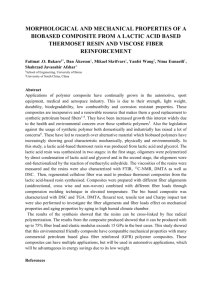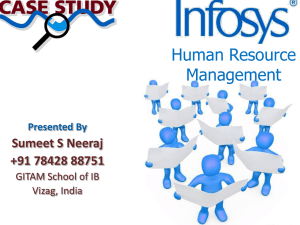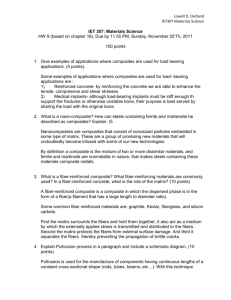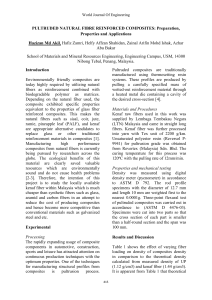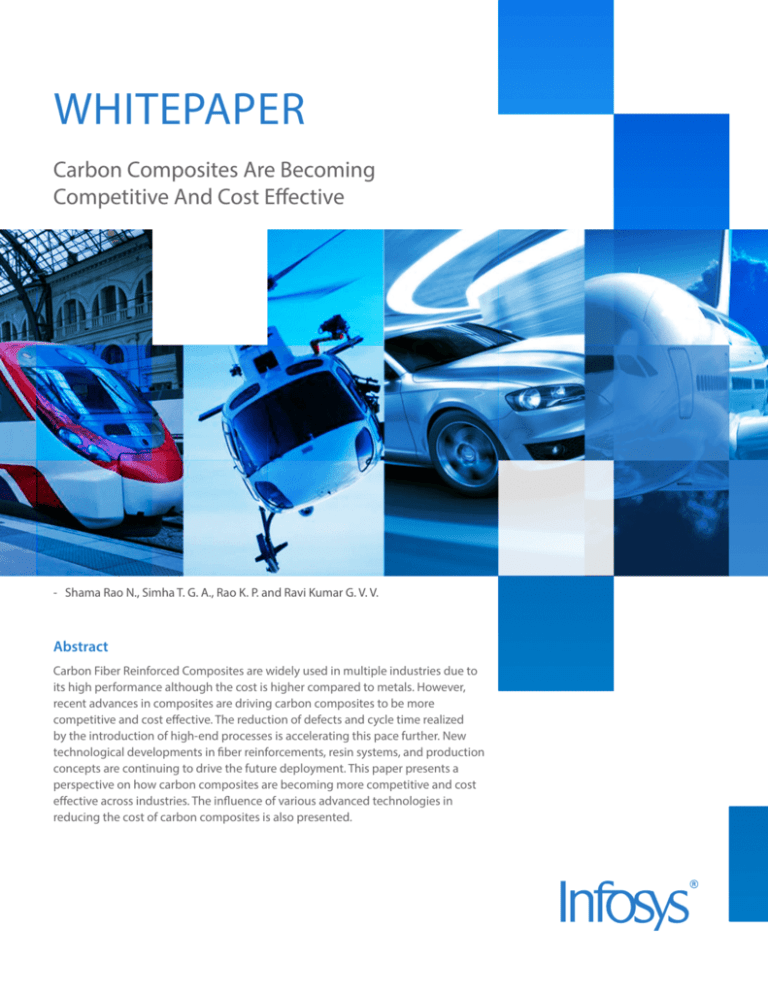
WHITEPAPER
Carbon Composites Are Becoming
Competitive And Cost Effective
- Shama Rao N., Simha T. G. A., Rao K. P. and Ravi Kumar G. V. V.
Abstract
Carbon Fiber Reinforced Composites are widely used in multiple industries due to
its high performance although the cost is higher compared to metals. However,
recent advances in composites are driving carbon composites to be more
competitive and cost effective. The reduction of defects and cycle time realized
by the introduction of high-end processes is accelerating this pace further. New
technological developments in fiber reinforcements, resin systems, and production
concepts are continuing to drive the future deployment. This paper presents a
perspective on how carbon composites are becoming more competitive and cost
effective across industries. The influence of various advanced technologies in
reducing the cost of carbon composites is also presented.
1.Introduction
Cost Comparison
90
80
70
PRICE USD PER KG
60
50
40
30
20
10
0
Steel
Titanium alloy Polyester and Carbon fiber
Epoxy Resins commercial
grade
Global Carbon Fiber Consumption
16%
13%
55%
9%
7%
Aerospace and Defense
Sports
Marine
Transportation
Other Industry
Figure 2. Global Consumption Carbon Fiber (2012)
PRICE IN USD PER KG
Trends and Forecast
35
160
30
140
120
25
100
20
80
15
60
10
40
5
20
0
0
2012
2013
2014
2015
2016
2017
2018
2019
YEAR
Price in $ per kg
Consumption Million tons
Figure 3. Trends and Forecast of Carbon fiber
External Document © 2015 Infosys Limited
Carbon fiber
aerospace
grade
Figure 1. Cost Comparison of Materials
Cost of the product is the major
factor prohibiting the wide spread
use of carbon composites in industry.
The following factors contribute to
reduction of cost
• High-volume processing
Aero grade
Aluminum
Alloy
MATERIAL
A typical cost comparison between
various materials is shown in Figure 1 and
Figure 2 presents the worldwide market
estimates for carbon fiber. Although, the
cost of carbon fibers is high, the market for
carbon fiber in non-aerospace structures
is increasing at a rapid rate as shown in
Figure 3.
• Reduction in cost of carbon fiber
• Availability of high performance
resins meeting production
automation requirements
• Cost effective product forms
• Cost effective production methods and automation with repeatable
high quality
• Availability of relevant design and
environment data on selected
composite systems
Aluminum
2020
CONSUMPTION IN MILLION TONS
Composites have been widely used across
industries like aerospace, wind energy,
automotive, industrial, marine, oil and
gas. Advanced carbon fiber composites
are comparatively more expensive than
metals. The choice of composites is a
tradeoff between cost and performance.
As a result, carbon composites have made
their impact in high performance vehicles,
such as, jet fighters, spacecraft, racing
cars, racing yachts and exotic sports cars.
The global composites materials market is
about $28Bn in 2014 and is growing at 1520% per year. This market size will further
grow provided the cost of composites is
reduced. The cost considered is primarily
the composite manufacturing cost.
However, for correct assessment entire life
cycle cost need to be considered including
maintenance and operation. Composites
provide a cost benefit particularly in
respect of operation and maintenance
which form a sizable percentage of direct
operating cost.
2. Recent Advancements in Polymer Matrix Composites
The effort to produce economically attractive composite components has resulted in several innovative manufacturing techniques. It is
obvious that improvement in manufacturing technology alone is not enough to overcome the cost hurdle. It is essential that there be
an integrated effort of key cost drivers as shown in the figure 4 for composites to become competitive with metals.
Raw Materials
Main raw materials of carbon composites
are polymeric resins and carbon fibers.
Cost of carbon fiber is directly related to
the cost and yield of precursor from which
it is obtained and cost of conversion. At
present carbon fiber is Polyacrylonitrile
(PAN) based and its average cost of nonaerospace grade is around $21.5/kg, with a
conversion efficiency of only 50%.
•
•
•
•
•
Development of low cost and high
yield precursors for manufacture of
commercial (heavy-tow) carbon fibers
which will significantly reduce the
carbon fiber cost. Industrial grade
fibers are expected to be available at
$13.8/kg by 2017. Figure 3 shows how
the cost of carbon fiber is going to get
reduced in future, till the year 2020,
due to some of these advances in raw
materials.
Chopped carbon fiber/epoxy prepregs
in Sheet Molding Compound (SMC)
form for structural applications with
processing times in minutes with
3-D molding capability that results in
dimensionally controlled surfaces on
both sides.
Production Technology
Utilization of Fluid based pressure/
heating/cooling systems
•
High speed compression molding
•
High pressure molding process method of forging net shaped parts
from prepreg bundles similar to metal
forging.
•
Rapid cure resin technology combined
with RTM for fabrics curing in 10
minutes.
Cost
Reduction
Raw materials
Figure 4. Key drivers for Cost reduction
Production Technologies
Many advanced production technologies
are in good state of development.
These have potential to reduce the
manufacturing and assembly costs while
capable of meeting the production
volumes of specific industries. Some of
them are:
•
Fast cycle manufacturing techniques
•
Lay-up automation and automation of
labour intensive activities
•
Development of highly moldable fast cycle prepregs, uni-directionally
arrayed chopped strand prepregs
Development of highly reactive resins
to reduce cycle time
Development in preform technology:
multi-ply curved complex preforms
such as skin-stringer/frame
intersections.
•
Advanced Software Tools
The following advances are taking place to
reduce the cost of carbon fiber:
•
Combining fibers to create hybrids and
weaving forms, re-use of waste fibers
by combining and consolidating dry
fibers into a mat
•
Flexible automated composite
laying processes
•
Textile processes like braiding ( 3-D)
and preform making,
•
Forming processes
Out of autoclave processes like resin
transfer molding and resin infusion
technology
Advanced Software Tools for
Composite Product Development
Many advanced composite software tools
and utilities are now available to automate
many engineering processes and to reduce
design cycle time. These tools identify
feasibility of manufacturing and associated
issues upfront during design stage. These
advanced software tools are helping to
perform many engineering activities
concurrently while reducing the design
cycle time and engineering cost. Few of
these tools include:
•
Advanced design, analysis and
manufacturing simulation software
tools and utilities
•
Knowledge Based Engineering Tools
•
Design for part integration and co-cure
methods
•
Design integrated virtual
manufacturing software systems
•
Cost modeling software.
External Document © 2015 Infosys Limited
3. Industry Specific Advances in Carbon Composites
Aerospace Industry
•
•
Compression molding of pre-pregs
•
High speed resin transfer molding
•
Resin spray transfer molding
Automotive Industry
•
Reactive injection molding
Recent advances in different areas of
composites in automotive industry can be
summarized into
Joining -fastening and bonding
Recent advances in aerospace structure
are:
•
•
Production of carbon fibers from Textile
PAN and/or melt spun PAN likely (cost
reduction by 15% to 20%)
Dry composite preforms, woven
structural braided reinforcements,
complex textile based architecture
associated with out- of- auto clave
curing such as RTM/Resin infusion and
e-beam curing
•
Availability of high performance fast
curing resins to meet the out-ofautoclave production processes.
•
Automated Dry Material Placement
(ADMP) – A newer approach to cut and
place ply patterns in one operation
eliminating pick up and placement
approach.
•
CNC controlled contour tape laying/
fiber placement machines with high
deposition rates
•
Manufacture of large parts through
Vacuum-Assisted Process (VAP) and
combined infusion of the different
parts (skin and stringers), avoiding
thousands of rivets and secondary
operations.
•
On-line quality control during
manufacturing process
•
Designing with heavy tows of
uni-directional materials without
compromising properties.
•
Custom built dry fiber tapes with
suitable binders, designed to be used
on current AFP machines to create dry
Preforms
Raw material:
•
•
Technological advances in the area
of low-cost fiber precursors such
as, cheaper polymers, inexpensive
textiles, low-quality plant fibers or
renewable natural fibers to meet auto
requirements in terms of properties.
Novel carbonization techniques
to produce useful, uniform fiber
properties at low cost
Materials and forms:
•
Multi-material system and Hybridscarbon and glass
•
Carbon /Epoxy SMCs
•
New and faster curing resins
•
Combination of material forms like
chopped fibers with continuous fibers
tailored to meet the requirement
•
•
Design criteria and design
methodologies
•
Tailoring of adhesives and mechanical
fasteners to suit Polymer Matrix
Composites (PMCs)
Marine Industry
Carbon composites are considered in
selected areas of marine industry in order
to achieve high performance with least
weight. Focused efforts are being pursued
in the following areas:
•
Generation of design and process data
comparable to design data sheets used
for steel construction
•
Development of material system and
designs
Stronger and durable adhesives
•
capable of functioning in hot -wet
environments
•
improved fire performance
characteristics
•
good damage resistance
Design:
•
Total integration of technologies
•
Advances in CAE
•
Effective NDT techniques
•
Change in mindset of designers
•
Cost effective and robust production
methods
•
Better integration methods with metals
•
Low cost hull mould concepts in large
sized hulls (>100 meters long)
•
Integrated approach in design, analysis,
testing, fabrication and assembly
techniques.
Rapid economic fabrication processes
capable of achieving high volume cost
effective structures:
•
External Document © 2015 Infosys Limited
Development in Preforms using many
passes of narrow bands of dry tape that
are consolidated as it is placed
High speed Compression Molding
Oil and Gas Industry
Rail Industry
Wind Energy
Carbon fiber Composites are recognized as
an enabling technology in deep-water and
ultra-deep-water (1500m - 3000m) drilling
scenarios. Many developments in areas of
design, manufacturing, NDT have taken
place. Some of the recent advances are
In order to meet the demands of high
speed rail industry prototype vehicles are
built using carbon composites. Recent
advances in this area include:
Turbines blades are increasingly large to be
cost effective which necessitates the use
of carbon fibers. Recent advances include
development of an integrated approach,
combining processes, and material and
design innovations. The areas of advances
include:
•
•
•
•
•
A number of standards for
design, manufacture and testing,
installation and maintenance were
issued by European committee of
standardization
•
Multi-axial, multilayered matte/wove/
UD reinforcements
•
Advanced pre-pregs to produce thick
sections of good quality eliminating
the need for compaction
•
Development of new core materials
that are
Reduction in cycle time for
development and validation of nonlinear FE models for composites.
•
Pre-preg compatible
•
Suitable for resin infusion with low
resin absorption characteristics
•
Familiarization of engineers with
composites
•
Higher thermal stability
•
•
Cost effective manufacturing
techniques for:
Epoxy resin reinforced with carbon
nanotubes resulting in half the weight
of fiber glass blade.
Cost effective routes for manufacture of
load bearing composites (main vertical
and deck elements).
Alternate designs, for example, in
the deck design, instead of sandwich
construction a linked assembly
of pultruded cellular elements
construction to achieve the necessary
degree of stiffness
Developments in low cost
manufacturing processes, like,
pultrusion of deep box beam section
with fibers in different orientations.
•
Development of resin infusion
moulding processes for very large
components with high quality
•
Reduction in carbon fiber costs
using cheaper precursors and better
conversion technologies
Standardization of Fire safety
regulations and issuance of
harmonized standards for Fire, Smoke
and Toxicity (FST) requirements
•
•
Techniques for design, simulation
and modeling of fire response
•
Universal composite material
system to meet stringent FST
requirements
•
Industrial reproducibility at cost
levels comparable to steel
•
Special thermoplastic coatings with
enhanced durability
•
Producing pre-equipped
subassemblies that can be
assembled quickly to form a coach
•
Thermoplastic composite materials and
processes
•
Application of automated technologies
to shorten cycle times, increase
precision and repeatability.
•
Automated Tape Layup (ATL) or
Automated Fiber Placement (AFP)
processes.
•
Sophisticated measurement,
inspection, testing and quality
assurance tools.
•
Generation of material and design
standards
•
Generation of Approved performance
requirements
External Document © 2015 Infosys Limited
A summary of the key parameters which will influence the cost of composites in future across industries is shown in Table 1.
Material
Aerospace
• Fast curing resins
• Carbon fiber from
textile PAN/melt
spun PAN
Automotive
Product forms
• Automation-tape
and dry fiber
placement
Others
• Use of heavy
tows of UD
• On-line quality
control
• Combination
of chopped/
continuous
multi material
systems
• Advancements
in CAE
• Low cost
reproducible
production methods
at cost levels
comparable to steel
Methods to produce
pre-equipped
subassemblies that
can be assembled
quickly to form a
coach
• Multi
material and
braided/
woven
hybrid
systems
• Efficient Design
simulation and
modeling of
fire response
solutions
• Automation-tape
and dry fiber
placement
• Dry
preforms
2D/3D
• PLM based
integrated
design
methodology
• Automation
in inspection
/ Quality
Assurance
• Durable coatings
• Durable
coatings
• Low cost
manufacturing
processespultrusion, resin
infusion moulding
• Development of
efficient designs
• Regulatory
requirements
standardization
• Improved
production
methods
• Generation of
design/process
data sheets
• Low cost molding
of large sized hulls
• Development of
damage resistant
design methods
• Out of autoclave
processes
• High volume
production
• Fast curing resins
• Compression
molding of prepregs
• Strong /durable
adhesives
Design
methods
• Dry
preforms
2D/3D
• Low cost carbon
fibers
• Carbon/EpoxySMCs
Processing
techniques
• Out-of-autoclave
processes-high
speed RTM, Reactive
RTM
• Better
integration
methods with
metals
• Automation in
adhesive bonding
Rail
industry
• Universal
composite material
system. to meet
Fire Smoke Toxicity
(FST) requirements
• Low cost fire
retardant resins
Wind
energy
• Low cost fibers
• Advanced
prepregs to reduce
production steps
• Core material
compatible with
new resins/
prepregs
Oil and
gas
• Cost effective
high temperature/
pressure resin
systems
• Low cost fibers
Marine
• Low cost fibers
• High performance
resins to meet
harsh environment
• High performance
coatings
• Automated
processes to ensure
short cycle times
with precision and
quality
Table 1. Cost Reduction Parameters Industry Wise
External Document © 2015 Infosys Limited
• standardization
of Fire safety
regulations
• Material and
design standards
• Design data
sheets
• Effective NDT
techniques
4. Cost Analysis
The manufacturing cost of a composite product is highly dependent on manufacturing process. For example, a stiffened panel can be
manufactured by autoclave process, resin transfer molding or compression molding. The major cost drivers are raw material, tooling, labour
and equipment. Costs of these vary with the chosen process of manufacture and on volume of production. Figure 5 gives cost of the above
parameters in percentage of total cost for a typical hand layup process for aerospace parts and various production volumes.
Production Volume = 200
10
Production Volume = 1000
10
14
30
29
25
35
10
16
Material
Labour
Tooling
Equipment
Overhead cost
Material
Labour
Tooling
21
Equipment
Overhead cost
Production Volume and Cost
Production Volume = 50,000
2500
10
2000
COST (USD)
10
5
55
20
1500
1000
500
0
100
Material
Labour
Tooling
Equipment
Overhead cost
Figure 5. Influence of Production Volume on Various Cost Line
1000
8000
PRODUCTION VOLUME PER ANNUM
Figure 6. Influence of Production Volume on Overall Cost
Items
External Document © 2015 Infosys Limited
All these technologies are in advanced stage and are expected to be production ready in few years from now. These are likely to reduce the
material cost by 15% to 30% and the manufacturing cost by another 15% to 20%. Considering these, a cost estimate in the current year and
in 2020 is made for a medium sized structural carbon/epoxy component with same mechanical performance as shown in shown Figure 7.
Autoclave Cure
2500
COST (USD)
2000
1500
1000
500
0
2014
2020
Raw Material Cost
2014
2020
Manufacturing Cost
2014
2020
Total Cost
RTM
1000
900
800
COST (USD)
700
600
500
400
300
200
100
0
2014
2020
Raw Material Cost
2014
2020
Manufacturing Cost
2014
2020
Total Cost
SMC – Compression Moulded
700
600
COST (USD)
500
400
300
200
100
0
2014
2020
Raw Material Cost
2014
2020
Manufacturing Cost
2014
2020
Total Cost
Figure 7. Cost Estimate in 2014 and 2020 of a medium size Carbon Composite Component
External Document © 2015 Infosys Limited
Conclusions
Carbon fiber reinforced composites (CFC) are becoming competitive and cost effective compared to metals.
At the current rates, CFC components are costlier compared to metal components. Many advances in raw
materials, manufacturing technologies, assembly techniques are influencing directly the cost of composites
design & development. These advanced technologies will help reducing the cost of composites substantially
which will spur the demand for composites exponentially in coming years. Composites design, analysis,
manufacturing tools will help in reducing the engineering cycle time, reduce the costs and improve the quality
while maintaining repeatability of parts being manufactured. This paper presents briefly various advances in
raw materials, manufacturing processes and software tools which will eventually drive down the cost per kg of
CFC in industry sectors such as, aerospace, automotive, marine, railway and oil and natural gas.
External Document © 2015 Infosys Limited
Acknowledgements
Thanks are due to Mr. Thirunavukkarasu K.S. for the timely help
provided in preparing this document. The authors would like to
thank Devaraja Holla V. for the detailed review and valuable inputs to
improve the document. The authors also would like to thank senior
management of engineering services practice of Infosys Mr. Srinivasa
Rao P, Mr. Manohar A. and Mr. Sudip Singh for their continuous
support and encouragement.
External Document © 2015 Infosys Limited
About the Authors
Dr Shama Rao N. is a Principal Consultant with Infosys since 2012. Prior to this he worked over 24 years
in various capacities in in Aeronautical Development Agency (ADA) Bangalore and retired as outstanding
scientist and project director. He also served over ten years in ISRO Satellite Centre, Bangalore and over seven
years at National Aerospace Laboratories (NAL) Bangalore. He obtained his doctoral degree in aerospace
engineering from IIT Bombay. His areas of interest are advanced composites technology, tooling, Aircraft
structures, assembly. Costing among others. He is a recipent of DRDO Scientist of the year 2009 award from
Prime Minister for his poineering work in composite technology for Light Combat Aircraft,Tejas.
T. G. A. Simha is a Principal Consultant with Infosys since 2002 and brings together more than 4 decades
of rich experience in Aerospace. Prior to Infosys, he was a project director of Indian LCA airframe at ADA,
Bangalore and Chief of stress at Hindustan Aeronautics Limited (HAL), Bangalore. He lead the design of
composite aircraft LCA and was involved in design of Kiran and Basant aircrafts. He was consultant for SARAS
and HANSA aircraft programs. At Infosys he provided technical leadership in airframe structures for more
than a decade and helped in executing many complex projects. He obtained MSc (Aircraft Design) from
Cranfield Institute of Technology UK, ME (Aeronautics) from Indian Institute of Science (IISc), Bangalore and
BE from Madras university. He is a life member of Aeronautical Society of India and life founder member of
ISAMPE. His work has been published as an ESDU data sheet. He has won many awards of excellence which
include, Dr. Ghatage Award of Aeronautical Society of India, National Aeronautical Prize of Aeronautical
Society of India and Distinguished Alumnus Award from IISc.
Prof K. P. Rao is a Principal Consultant with Infosys since 2002 and brings together more than 4 decades of
rich experience in composites in Aerospace. Prior to Infosys, he was a professor in aerospace engineering at
IISc, Bangalore during 1969-2002 and at HAL, Bangalore during 1964-1966. He was consultant and reviewer
of all the major Indian commercial and defense aircraft programs and space projects. Some of these include
Tejas, Hansa, PSLV and Lakshya. At Infosys he provided technical leadership in airframe structures for more
than a decade and helped in executing many complex projects. He obtained DIC (Aeronautics) and PhD
(Aircraft Structures) from Imperial College, London, UK and ME (Aeronautics) and BE from IISc, Bangalore.
He is a fellow of Institution of Engineers (India), Aeronautical Society of India and National Academy of
Engineering (India). He has published more than 100 technical papers in journals and proceedings of
conferences. He has won many awards of excellence which include, Excellence in Aerospace Education
Award from Aeronautical Society of India, Prof. Satish Dhawan Chair, Academic Excellence Award from DRDO,
Astronautical Society of India Award and Distinguished Alumnus Award from IISc.
Dr Ravikumar, G.V.V. is Senior Principal and Head Advanced Engineering Group (AEG) brings together
20 years of research and industrial experience in Aircraft Industry. His areas of interest include Aircraft
Structures, Knowledge Based Engineering, Composites and Structural Health Monitoring. He authored more
than 30 technical papers in various journals/conferences/white papers and filed a patent. He worked on
various prestigious engineering design and development, KBE tool development projects for both military
and commercial aircraft programs including Indian light combat aircraft (LCA). He obtained his doctoral
degree in Applied Mechanics from IIT Delhi. He worked in Tata Research Design and Development Center
(TRDDC), Pune and Aeronautical Development Agency (ADA) Bangalore prior to joining Infosys.
External Document © 2015 Infosys Limited
About Infosys
Infosys is a global leader in consulting, technology, outsourcing and next-generation services. We enable clients, in more than 50 countries, to stay a
step ahead of emerging business trends and outperform the competition. We help them transform and thrive in a changing world by co-creating
breakthrough solutions that combine strategic insights and execution excellence.
Visit www.infosys.com to see how Infosys (NYSE: INFY), with US$8.25 B in annual revenues and 165,000+ employees, is helping enterprises renew
themselves while also creating new avenues to generate value.
For more information, contact askus@infosys.com
www.infosys.com
© 2015 Infosys Limited, Bangalore, India. All Rights Reserved. Infosys believes the information in this document is accurate as of its publication date; such information is subject to change without notice.
Infosys acknowledges the proprietary rights of other companies to the trademarks, product names and such other intellectual property rights mentioned in this document. Except as expressly permitted,
neither this documentation nor any part of it may be reproduced, stored in a retrieval system, or transmitted in any form or by any means, electronic, mechanical, printing, photocopying, recording or
otherwise, without the prior permission of Infosys Limited and/ or any named intellectual property rights holders under this document.

